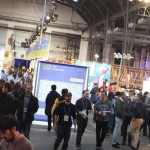Big data versus Big Brother. Do we want Barcelona to be the smart city to lead all smart cities? Or should the Catalan capital simply save time and money by utilizing open source code to copy other pioneering cities?
The 2014 Smart City Expo at Fira Barcelona definitely talked about success being found in a mix of the two. The Mobile World Capital saw 232 businesses and a whopping 400 cities come together to share ideas on how to collaborate and modernize more efficient cities for less money.
With 70 percent of the world living in cities by 2050, there’s money to be made, with the smart city market predicted to grow $174 billion by 2023.
But it’s not all about money. Certainly for us Barcelona residents, we want to know how smart city innovation can and will affect our day to day, which is just what BarcInno endeavors to address now…

First, what IS a smart city?
Fair question. It’s a rather obtuse buzzword which brings together a mix of technology, municipal governments, and the private sector, supposedly with the citizen at the center of it all. It usually involves smartphones, but is certainly delving into wearables and other every day items, like the Nest thermometer. Most often a smart city is talked about in reference to safety, security, sanitation and/or energy, but with public-private partnerships, these blur into simply ways technology can improve the lives of citizens and the business of businesses.
So far our smart city isn’t very centralized…
Across Barcelona, different aspects of the public and private sectors are getting optimized online.
At El Prat Airport, all elements not associated with the airplane itself—from elevators to control to shopping—are integrated into a platform built by Schneider Electric. Think about how first they scan your ticket before you go through security, then if you buy any non-food items they need to scan, and then they scan you to board. Someone knows where you are at all times, and if you aren’t boarding, they call you on the loudspeaker, so you don’t miss your flight. If you still don’t appear, guardia civil is notified to investigate what happened to you.
But it’s not just about a case by case basis, but the valuable big data that comes with. Airport shops scan your boarding pass to gather information on where their regular clients are going and with whom. If clientele is mostly budget airlines, they may order and place snacks more prominently, while they may lead with Gucci for more glamorous clients.
The airport records this shopping data for market research too. Maybe El Prat is finally getting a Victoria’s Secret because American girls are the most active pre-boarding shoppers.
But eventually a smart city should enable collaboration.
Many bus stops in Barcelona are solar-powered, but our sunny city provides much more energy than an electronic timetable needs. Wouldn’t it be great if that surplus juice went to power more WiFi hotspots?
And many of the traffic lights have cameras already with dual safety and security functionality to catch red-light runners in the act, while monitoring street activity. Wouldn’t it be great if the data gathered by these cameras also was shared with city planners who could base construction and rerouting needs on traffic patterns? Or lengthen red lights so pedestrians have longer to cross in shopping districts during rebajas? If ONCE could witness and weigh in on how to optimize the crosswalk notifications for the blind?
An important recurring theme of this year’s Smart City Expo wasn’t just the bells and whistles but about different cities publishing on sites like GitHub in order to collaborate and share code, allowing different cities to duplicate success and allowing citizens and private business to build use cases on top of public data.
Barcelona seems to be on the cusp of opening up its data so it can be used and reused to better serve the population. To follow (mostly in Catalan) how that process is going, go for hashtag #SmartCityDiba.

Bicing could be the perfect Internet of Things
A smart city can also be a hybrid of tech solutions with old school or current infrastructure. A perfect example of this is Bicing, Barcelona’s bicycle rental system. Unlike hilly Madrid which is going for electric bikes, Barna’s flat service makes man-powered bikes a reasonable and less expensive tool, even with neat, pedal-powered lights.
The Internet of Things or IoT comes with the app and the bike rack sensors it talks to. When you first rent a bike, you have a couple minutes to check it out, making sure it’s in perfect condition. If not, you can exchange it for a new bike and report that flat tire via the app. Residents use the Bicing app to find the safest route—which should reflect construction and traffic—to the vacant bike rack nearest to their destinations.
But, if you’ve ever tried to bike on down to Barceloneta on a Saturday, you may be frustrated by row after row of full bike racks, while the time is ticking to return your commuter-centric Bicing before the 30-minute limit is up. When city workers and rack sensors are in perfect harmony, the bike flatbeds truck down to collect bikes for redistribution from whence they came in Eixample.
So, how smart IS Barcelona?
Again, great question. Well, since the essence of a smart city is democratic and responsive, our city can only be as smart as its people. Of course, the fact that Spain has more smartphones per capita than any other European country certainly helps it along.
But let’s ask you—IS Barcelona the smartest of it all? Where is this smart city muy lista and where does it just needs to find a clue? Or are we better off the grid? Tell us below!







Leave a Reply